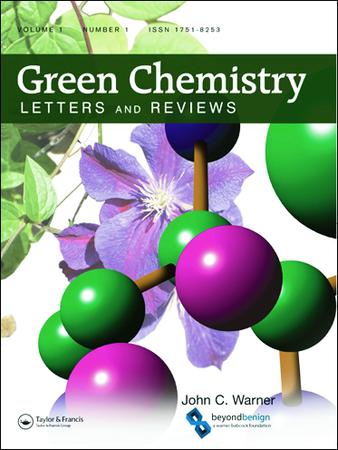Effect of Musa acuminata peel extract on synthesis of ZnO/CuO nanocomposites for photocatalytic degradation of methylene blue
IF 5.8
3区 化学
Q1 CHEMISTRY, MULTIDISCIPLINARY
引用次数: 1
Abstract
ABSTRACT The photocatalytic degradation of the organic pollutants using the green synthesized catalysts is an environmentally safe approach for the wastewater treatment. In this study, ZnO and CuO nanoparticles (NPs) and ZnO/CuO nanocomposites (NCs) with various CuO weight percents were synthesized using extract of Musa acuminata fruit peel as the stablizing and capping agent. The synthesized nanomaterials were characterized by TGA/DTA, XRD, SEM, TEM, SAED, HR-TEM, UV-DRS and FTIR techniques. The degradation of methylene blue (MB) dye using the synthesized catalysts was investigated under a visible light source. XRD analysed average crystalline sizes were 24.9, 17.0 and 22.6 nm for ZnO, CuO, and ZnO/CuO nanomaterials, respectively. The SEM and TEM analysis confirms that ZnO NPs, CuO NPs, and ZnO/CuO NCs possessed the spherically shaped monoclinic structure. The bandgap energies of ZnO NPs, CuO NPs and ZnO/CuO NCs were found to be 3.25, 1.7 and 3.18 eV respectively. The FT-IR analysis confirms presence of various reducing and capping agents. The photocatalytic activities of ZnO NPs, CuO NPs, and ZnO/CuO NCs were evaluated using the degradation of MB dye under the visible light irradiation. The photocatalysts CuO, ZnO, and ZnO/CuO exhibited the degradation efficiencies of 50%, 57%, and 90%, respectively. GRAPHICAL ABSTRACT麝香皮提取物对合成光催化降解亚甲基蓝用ZnO/CuO纳米复合材料的影响
本文章由计算机程序翻译,如有差异,请以英文原文为准。
求助全文
约1分钟内获得全文
求助全文
来源期刊

Green Chemistry Letters and Reviews
CHEMISTRY, MULTIDISCIPLINARY-GREEN & SUSTAINABLE SCIENCE & TECHNOLOGY
CiteScore
9.10
自引率
3.00%
发文量
48
期刊介绍:
Green Chemistry Letters and Reviews is an Open Access, peer-reviewed journal focused on rapid publication of innovative new syntheses and procedures that reduce or eliminate the use and generation of hazardous materials. Reviews of state-of-the-art green chemistry technologies are also included within the journal''s scope.
Green Chemistry Letters and Reviews is divided into three overlapping topic areas: research, education, and industrial implementation. The journal publishes both letters, which concisely communicate the most time-sensitive results, and reviews, which aid researchers in understanding the state of science on important green chemistry topics. Submissions are encouraged which apply the 12 principles of green chemistry to:
-Green Chemistry Education-
Synthetic Reaction Pathways-
Research and Process Analytical Techniques-
Separation and Purification Technologies-
Renewable Feedstocks-
Degradable Products
 求助内容:
求助内容: 应助结果提醒方式:
应助结果提醒方式:


